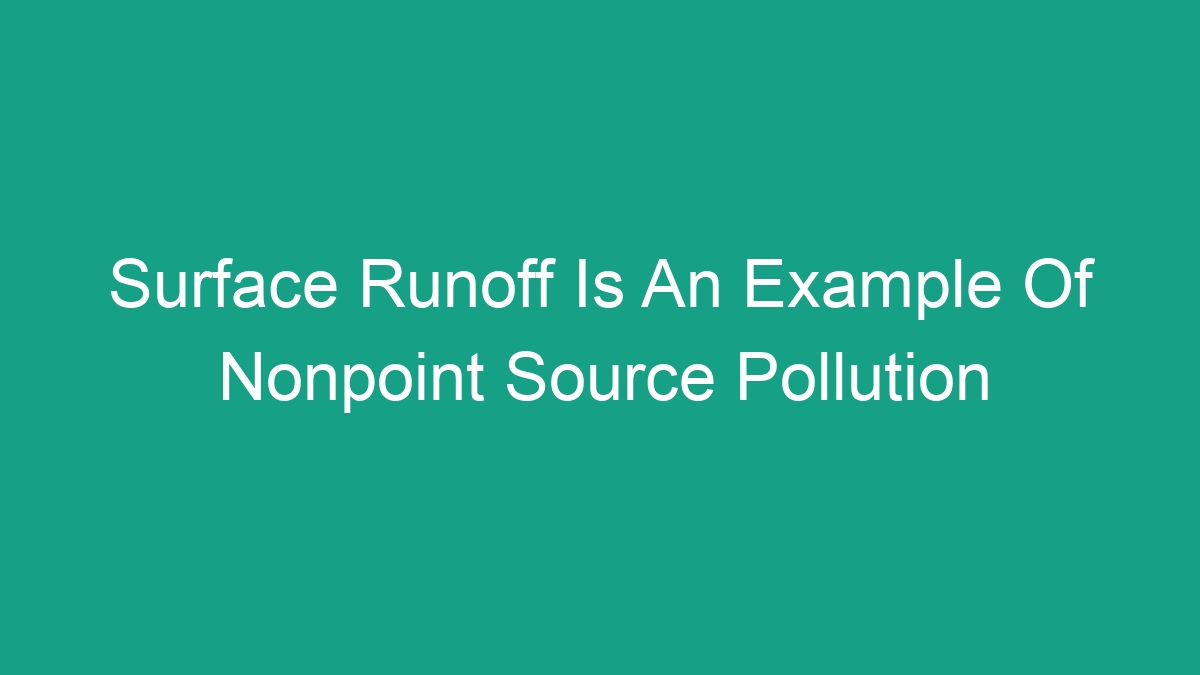
Nonpoint source pollution occurs when contaminants enter a water body from diffuse sources, making it challenging to pinpoint the exact origin of the pollutants. Surface runoff is a common example of nonpoint source pollution, and it poses significant environmental and public health risks. In this article, we will explore the impacts of surface runoff as a nonpoint source of pollution and discuss potential solutions to mitigate its effects.
Understanding Surface Runoff
Surface runoff refers to the flow of water over the ground surface, typically as a result of precipitation. As the water moves across the land, it can pick up various pollutants and carry them into nearby water bodies such as rivers, lakes, and oceans. These pollutants can include sediments, nutrients, pesticides, heavy metals, and other harmful substances.
Surface runoff can be exacerbated by urbanization, deforestation, and agricultural practices that alter the natural landscape and increase the flow of water over impervious surfaces. This can lead to higher volumes of polluted runoff entering water bodies, causing a range of ecological and public health issues.
Impacts of Surface Runoff as Nonpoint Source Pollution
The impacts of surface runoff as a nonpoint source of pollution are wide-ranging and can have detrimental effects on both aquatic ecosystems and human health. Some of the key impacts include:
- Water Quality Degradation: Runoff can introduce high levels of sediment, nutrients, and chemicals into water bodies, leading to decreased water quality. Excessive nutrients such as nitrogen and phosphorus can cause eutrophication, leading to algal blooms and oxygen depletion in aquatic environments.
- Habitat Destruction: Sediment-laden runoff can smother aquatic habitats, disrupt the natural balance of ecosystems, and harm aquatic organisms such as fish and invertebrates.
- Public Health Risks: Polluted runoff can contaminate drinking water sources and recreational waters, posing health risks to humans through exposure to pathogens and harmful chemicals.
- Loss of Biodiversity: The introduction of pollutants into water bodies can result in the loss of biodiversity, as sensitive species may be unable to survive in degraded habitats.
Solutions to Mitigate Surface Runoff Pollution
Addressing surface runoff as a nonpoint source of pollution requires a multi-faceted approach that focuses on both prevention and treatment. Some effective solutions to mitigate the impacts of surface runoff pollution include:
- Green Infrastructure: Implementing green infrastructure practices such as permeable pavement, green roofs, and rain gardens can help capture and infiltrate runoff, reducing the flow of pollutants into water bodies.
- Riparian Buffers: Establishing vegetated buffers along waterways can help filter and trap pollutants, reducing the amount of contaminants entering aquatic ecosystems.
- Soil Conservation Practices: Employing erosion control measures such as cover crops and contour plowing can minimize soil erosion and the transport of sediment into water bodies.
- Education and Outreach: Educating the public about the impacts of surface runoff pollution and promoting responsible stormwater management practices can help increase awareness and engagement in mitigation efforts.
- Regulatory Measures: Implementing and enforcing regulations to reduce the discharge of pollutants from industrial, agricultural, and urban sources can help minimize the contribution of nonpoint source pollution to surface runoff.
Conclusion
Surface runoff as an example of nonpoint source pollution presents significant challenges in protecting water quality and preserving ecosystems. By understanding the impacts of surface runoff and implementing effective solutions to mitigate its effects, we can work towards safeguarding our watersheds and ensuring the health of aquatic environments for future generations.
It is essential for all stakeholders, including governments, industries, communities, and individuals, to collaborate in addressing surface runoff pollution and promoting sustainable practices that minimize nonpoint source pollution. By doing so, we can strive towards cleaner water, healthier ecosystems, and a safer environment for all.


